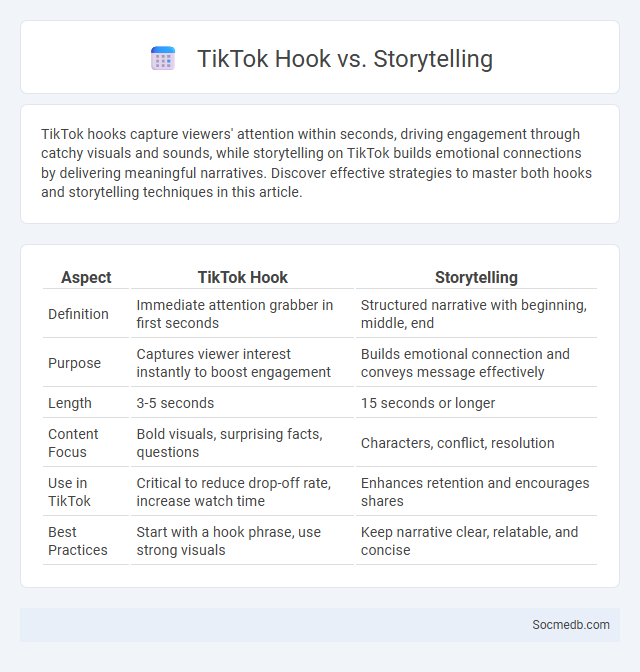
Photo illustration: TikTok Hook vs Storytelling
TikTok hooks capture viewers' attention within seconds, driving engagement through catchy visuals and sounds, while storytelling on TikTok builds emotional connections by delivering meaningful narratives. Discover effective strategies to master both hooks and storytelling techniques in this article.
Table of Comparison
| Aspect | TikTok Hook | Storytelling |
|---|---|---|
| Definition | Immediate attention grabber in first seconds | Structured narrative with beginning, middle, end |
| Purpose | Captures viewer interest instantly to boost engagement | Builds emotional connection and conveys message effectively |
| Length | 3-5 seconds | 15 seconds or longer |
| Content Focus | Bold visuals, surprising facts, questions | Characters, conflict, resolution |
| Use in TikTok | Critical to reduce drop-off rate, increase watch time | Enhances retention and encourages shares |
| Best Practices | Start with a hook phrase, use strong visuals | Keep narrative clear, relatable, and concise |
Introduction to Hooks and Storytelling on TikTok
Hooks on TikTok grab your audience's attention within the first few seconds, utilizing captivating visuals, sounds, or questions to boost engagement rates. Storytelling on TikTok involves concise yet compelling narratives that resonate emotionally, encouraging shares and comments. Mastering these elements increases your video visibility and follower growth on the platform.
Defining the TikTok Hook: What Grabs Attention?
The TikTok hook captures attention within the first few seconds using vibrant visuals, bold text, or intriguing questions that provoke curiosity. Your content must leverage trending sounds and relatable scenarios to create an immediate emotional connection with viewers. Short, dynamic clips paired with compelling storytelling ensure users stay engaged and scroll less.
Storytelling Techniques on TikTok Explained
TikTok leverages short-form video storytelling techniques that emphasize authenticity, relatability, and visual engagement to capture audience attention quickly. Creators use trends, sound bites, and creative editing tools like jump cuts and overlays to craft compelling narratives within seconds. The platform's algorithm favors content that evokes emotional responses or encourages interaction, making concise, emotionally resonant storytelling crucial for viral success.
The Psychological Power of a Strong Hook
A strong hook on social media captures immediate attention by triggering emotional responses such as curiosity, surprise, or empathy, which enhances content engagement and retention. Psychological studies demonstrate that users are more likely to interact with posts that evoke strong feelings within the first few seconds, increasing shareability and algorithmic visibility. Crafting hooks that leverage storytelling, bold statements, or relatable questions taps into cognitive biases like the Zeigarnik effect, driving users to seek resolution through further interaction.
Storytelling vs. Hook: What Drives Engagement?
Storytelling creates emotional connections by sharing authentic narratives, making your audience more likely to engage and remember your content. Hooks capture immediate attention with compelling headlines or visuals, driving initial clicks and curiosity. For maximum engagement, balance a strong hook to attract viewers with a meaningful story that sustains interest and encourages interaction.
TikTok Hook: Examples That Work
TikTok hook examples that work include intriguing questions, bold statements, and visually captivating scenes within the first 3 seconds to capture viewer attention. Popular formats involve quick cuts, unexpected transitions, and relatable humor tailored to TikTok's younger demographic. Leveraging trending sounds and hashtags further enhances engagement and discoverability on the platform.
Integrating Storytelling with the Hook for Maximum Impact
Integrating storytelling with a compelling hook significantly enhances social media engagement by captivating audiences within the first few seconds. Crafting narratives that evoke emotion and curiosity encourages sharing and increases reach, leveraging platforms' algorithms favoring content retention. Strategic use of relatable characters, vivid imagery, and authentic voice builds trust and fosters community, driving deeper connection and brand loyalty.
Common Mistakes: Hook Fails vs. Storytelling Flops
Social media success hinges on mastering hooks and storytelling; hook fails occur when your opening lacks emotional impact or curiosity, causing users to scroll past without engagement. Storytelling flops happen when your content lacks a clear narrative arc or relatable characters, making it hard for your audience to connect and remember your message. Understanding these common mistakes helps you craft compelling posts that capture attention and foster deeper connections with your followers.
Optimizing Your Content: When to Use Hook, Storytelling, or Both
Optimizing your social media content involves strategically choosing between hooks, storytelling, or a combination of both to maximize engagement. Use hooks to capture immediate attention in the first few seconds, especially in platforms like Instagram Reels, TikTok, or Twitter, where fast-scrolling users seek quick value. Incorporate storytelling to deepen emotional connection and brand loyalty, ideal for longer formats such as YouTube videos or Facebook posts, while blending both techniques can enhance retention and sharing potential across diverse audiences.
Conclusion: Winning TikTok Strategies for Creators
Successful TikTok creators leverage trending sounds, authentic storytelling, and consistent posting schedules to maximize engagement and follower growth. Employing niche-specific hashtags and collaborating with other influencers enhances visibility and community building. Understanding TikTok's algorithm and audience behavior remains crucial for sustained content performance and creator success.
 socmedb.com
socmedb.com